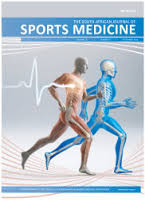The prevalence, risk factors predicting injury and the severity of injuries sustained during competition in professional mixed martial arts in Africa
DOI:
https://doi.org/10.17159/2078-516X/2017/v29i1a2939Abstract
Background: Professional mixed martial arts (MMA) has gained international popularity. No African-based studies have reported the prevalence or severity of injuries, risk factors associated with injuries or return-to-play (RTP) time. Objectives: To determine the prevalence of injuries and associated risk factors, as well as severity of injuries sustained by professional male MMA athletes competing at the Extreme Fighting Championships Africa (EFC Africa) from 2010 to 2014.
Methods: Permission to do the study and the medical records of all professional events (2010 – 2014) were obtained from EFC Africa. Data were obtained from 173 male competitors aged 18 to 44 years, who had participated in 300 professional MMA fights. Results from this prospective cohort study were compared to a similar study done in the United States of America (USA). An injury was defined as any damage to an athlete’s body that needed the attention of the ringside physician. Statistical analyses included descriptive statistics and a stepwise logistic regression. Odds of an injury were predicted with six independent variables: fight outcome, age, weight division, number of fights, injuries in the preceding fight and years of fighter experience.
Results: Head, face and neck injuries were most common (22%), followed by traumatic brain injuries (knockouts) (6%). Losing a fight was a significant predictor of injury when using the stepwise logistic regression model (p=0.040). The odds ratio indicated that a preceding fight injury almost doubled the risk of injury in the following fight (OR 1.91; p= 0.163). Traumatic brain injuries (TBIs) in this study of African-based competitions (6%) were substantially higher than reported in the American study (1.8%).
Conclusion: Head, neck and face injuries are common in African fighters. The high rate of TBIs in African competition compared to the USA study is concerning. This could reflect superior refereeing in the USA group, as fights may be ended sooner by stoppage. Further investigation of injury trends and preventative measures should be studied to reduce the incidence of injuries during African competitions.
Downloads
Downloads
Published
Issue
Section
License
Copyright (c) 2017 South African Journal of Sports Medicine

This work is licensed under a Creative Commons Attribution 4.0 International License.
The South African Journal of Sports Medicine reserves copyright of the material published. The work is licensed under a Creative Commons Attribution 4.0 (CC BY 4.0) International License. Material submitted for publication in the South African Journal of Sports Medicine is accepted provided it has not been published elsewhere. The South African Journal of Sports Medicine does not hold itself responsible for statements made by the authors.
How to Cite
- Abstract 492
- PDF 515






.png)